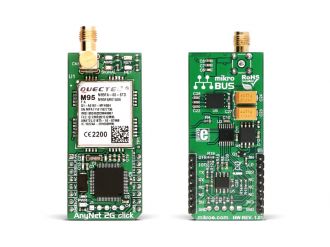
We strongly encourage users to use Package manager for sharing their code on Libstock website, because it boosts your efficiency and leaves the end user with no room for error. [more info]

Rating:
Author: MIKROE
Last Updated: 2017-11-23
Package Version: 1.0.0.0
Category: GSM/LTE
Downloaded: 893 times
Not followed.
License: MIT license
AnyNet 2G click is a cellular to AWS gateway device, which provides developers with the complete solution for various IoT applications, by using the AWS IoT and Cloud Storage services for the data storage, analyzing and processing.
Do you want to subscribe in order to receive notifications regarding "AnyNet 2G click" changes.
Do you want to unsubscribe in order to stop receiving notifications regarding "AnyNet 2G click" changes.
Do you want to report abuse regarding "AnyNet 2G click".
| DOWNLOAD LINK | RELATED COMPILER | CONTAINS |
|---|---|---|
| 1511338632_anynet_2g_click_mikroc_pic32.zip [37.46KB] | mikroC PRO for PIC32 |
|
| 1511338641_anynet_2g_click_mikroc_arm.zip [37.85KB] | mikroC PRO for ARM |
|

Library Description
The library is composed of driver and API layers both available from user space. Lower driver layer carries generic AT command parser, API layer carries simplified user-friendly function calls.
Key functions
api_anynet2g_queryICCID- Provides ICC ID necessary for registration
api_anynet2g_checkStateAWS- Returns current state of the module
api_anynet2g_openTopicAWS- Opens Topic
Examples descriptions
The example shows how to properly initialize module and use API function calls. All information from the module is logged using UART so two UART modules are necessary for the example. In case that your system has only one UART module, Software UART is also usable for data logging.
// MODULE INIT anynet2g_cmdSingle( "AT" ); api_anynet2g_firmwareID(); api_anynet2g_queryICCID(); api_anynet2g_checkStateAWS( _ANYNET2G_GET ); // OPEN TOPIC 0 AND PUBLISH api_anynet2g_openTopicAWS( _ANYNET2G_SET, "0", "MY_TOPIC" ); api_anynet2g_publishTopicAWS( _ANYNET2G_SET, "0", "MIKROE", "" );
In addition to API calls, example carries additional functions for GPIO pin control provided during the driver initialization.
Keep in mind that AnyNet 2G click currently doesn't support Hardware Flow control so implementation of UART interrupt is a must, also timer interrupt is needed.
Other mikroE Libraries used in the example:
Additional notes and information
Depending on the development board you are using, you may need USB UART click, USB UART 2 clickor RS232 click to connect to your PC, for development systems with no UART to USB interface available on the board. The terminal available in all Mikroelektronika compilers, or any other terminal application of your choice, can be used to read the message.